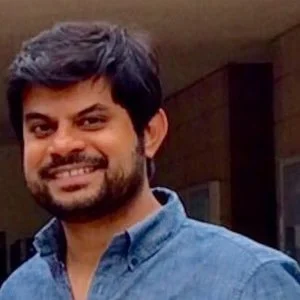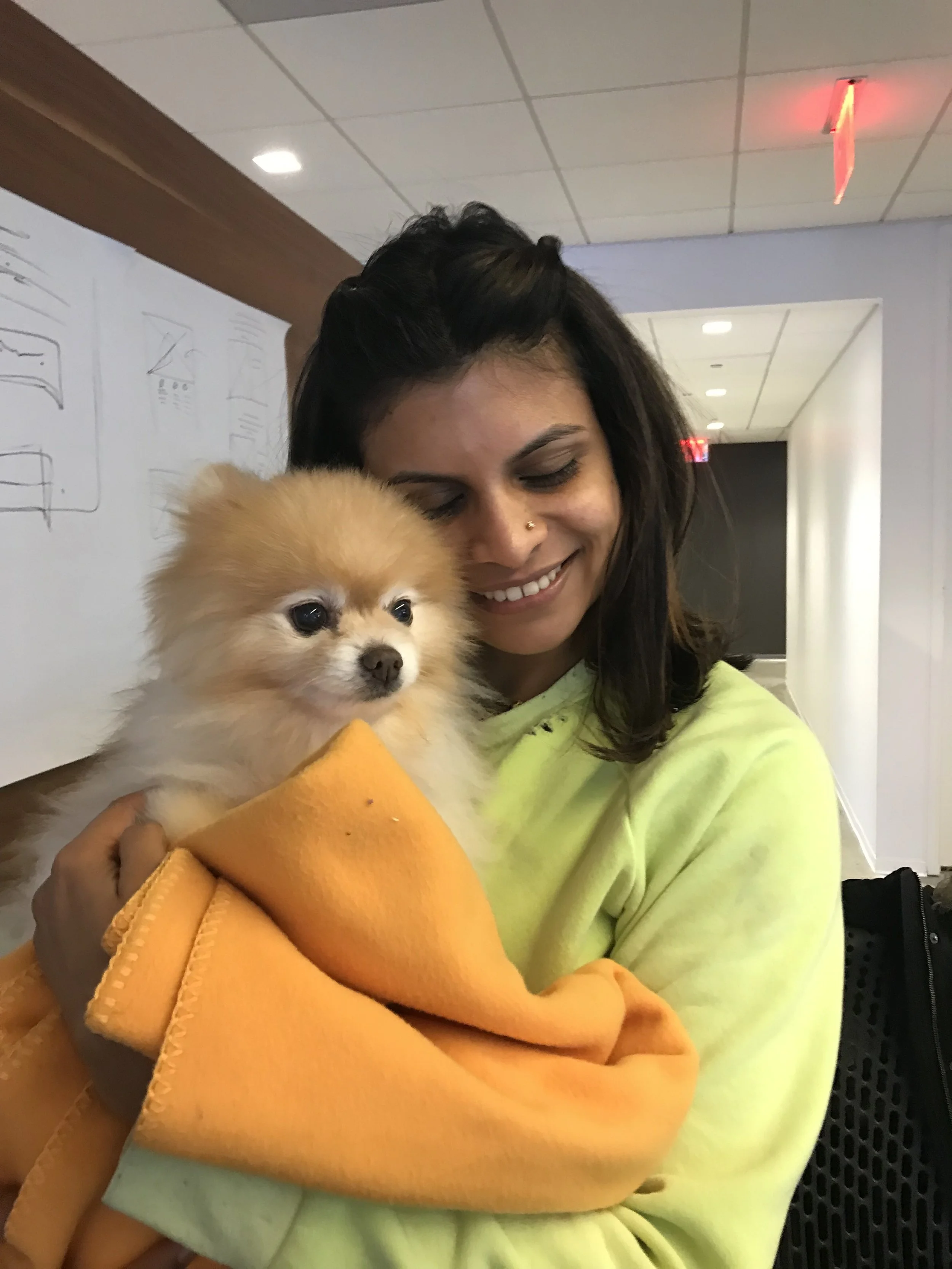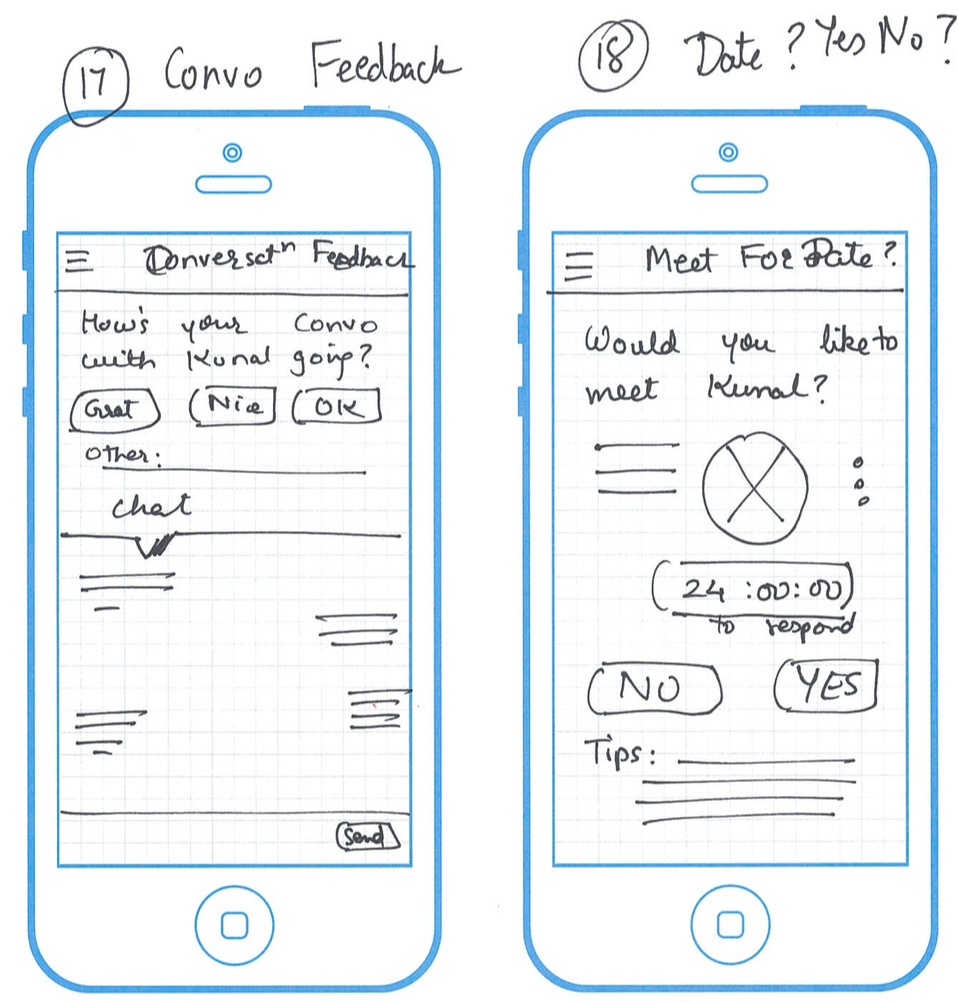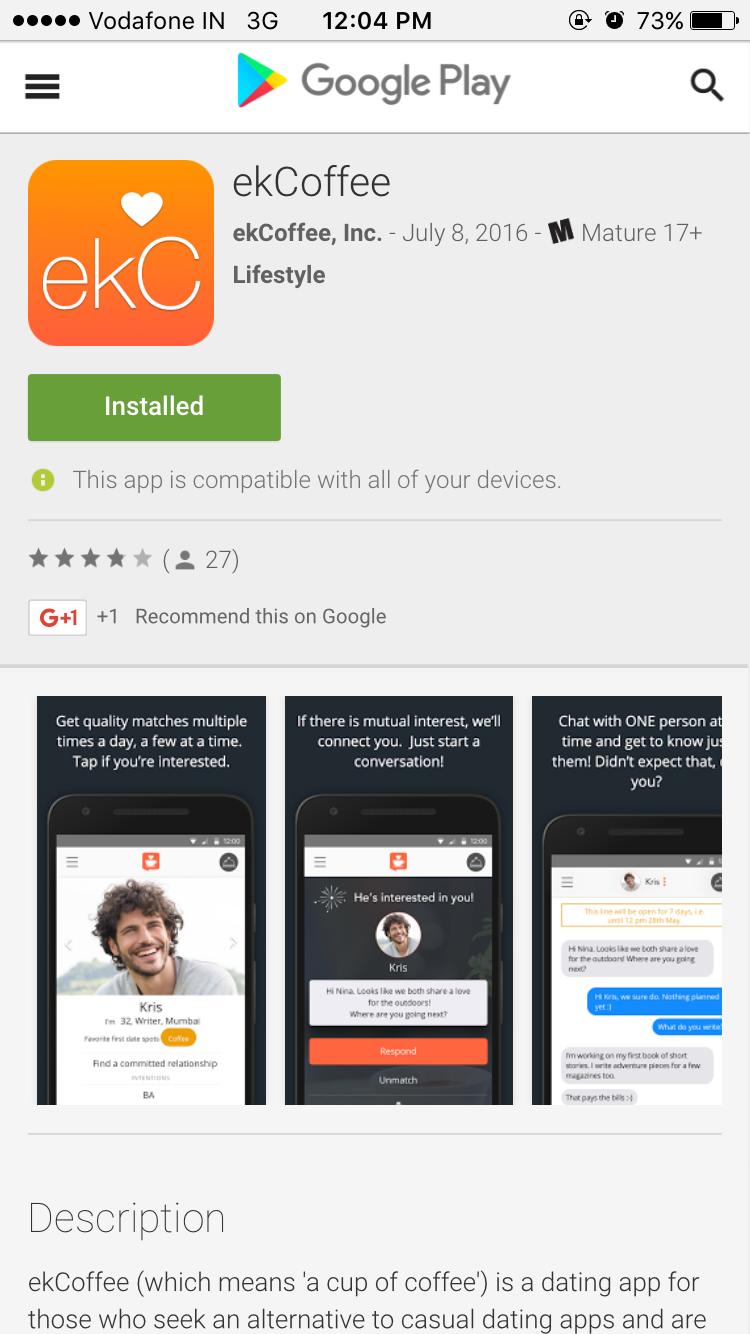iOS & Android app design
CONCEPTUALIZED, DESIGNED & LAUNCHED AN END-TO-END DATING PRODUCT
THE ‘EK-COFFEE’ DATING APP STORY
(AK-coffee) (AK as in accolade) | Source: ‘ek’ means one in the Hindi language.
CONTAINS:
END-TO-END PRODUCT DESIGN (UX, VISUAL, DEVELOPMENT & TESTING), IOS & ANDROID MOBILE APP DESIGN, USER RESEARCH, MARKET RESEARCH, AGILE DEVELOPMENT, MVP DESIGN, WIREFRAMING, VISUAL DESIGNING, PROTOTYPING, USABILITY TESTING, MARKETING, GROWTH HACKING.
Henceforth, we’ll address ‘ekCoffee’ as Brew for ease of pronunciation and understanding.
THE PROBLEM
Ghosting, bread-crumbing, slow fading, sexting - sounds like familiar dating app language? Between 2014-2017, in-spite of using tons of dating apps, singles in India were still having a hard time finding real life meaningful connections.
OUR SOLUTION
In June of 2016, we launched the Brew dating app for singles who seek more than just swipes & chats. We created a high touch dating app that educated and provided online and offline experiences for singles who were seeking an alternative to casual dating apps. We launched the iOS and Android apps, pivoted a few times and helped a thousand odd singles experience what better a dating app feels like.
THE TEAM
My role: Co-founder and product designer. As a co-founder I led the product & user experience design and spearheaded user-growth, online & offline marketing, community building, and managing Brew’s social media.
My responsibilities: User research, talking to singles from India and US, using data to inform the app design, app design using Sketch, prioritizing MVP & feature set, co-ordinating with developers in an Agile development, marketing & growth hacking, finding product market fit.
Timeline: ~3 years, Jan 2014 - Oct 2017
Backstory
Back in 2004, online dating was not as mainstream as it is now. My brother Vineet, who was then based out of San Francisco, had trouble finding meaningful relationships online. It was even harder to find someone with a similar cultural background as arranged marriage portals mainly dominated this scene. Due to lack of an informal, modern yet contemporary online dating space, Vineet identified a real problem. He built and launched an online dating site in India just as a side-hustle.
Fast forward January of 2014, I was in a similar boat, trying to find a real and meaningful relationship without having to go through the traditional matrimonial route (#NewYearGoals). This was also when apps were booming in India. Being of south asian descent, we understood the online dating space for South Asians really well; this gave birth to the idea of building & launching a dating app for urban singles in India. It would be called Brew. The app was positioned to disrupt the traditional ways of meeting singles in India but with a purpose of finding real, meaningful relationships.
Learning about the modern urban single millennial of India.
Misery always finds company. Building a solution that stems from a personal experience is great, it’s 2X better if you know it’s everyone else’s problem too.
My brother and I were regular users of US based dating apps and knew the problems associated with them. However, we wanted to identify, prove and disprove our assumptions about the urban singles back in India. Having grown up in India and having a ton of friends back home, we were able to perform qualitative & quantitative surveys & tests to identify the needs, goals, and mental models of Indian singles.
To get started, I carried out a few quantitative and qualitative surveys with friends & friends of friends using good old Facebook.
Between Jan - May 2014, I carried out market & cultural survey of 38 single Indians (men and women) between the ages of 23-35 yrs to identify mass pain-points. I then performed ethnographic research and interviews with 3 women & 2 men to understand the context in which they would use our app.
Some key pain-points were:
Majority urban single Indians were sick of meeting other interesting singles through traditional matrimonial and wanted better alternatives.
Although open to trying new services, there was a general negative connotation around using dating apps.
Women are more concerned about safety and were not open to the thought of meeting strangers via an online dating app.
To further drill down into the systematic study of single Indians and how culture plays an important part in their dating preferences, I performed ethnographic research on 12 single Indians.
I carried out an ethnographic research involving 12 Indian singles to understand how dating apps play a role in their lifestyle. We found that majority Indians don’t take dating dating apps seriously. Majority women complained that they were overwhelmed with the number of messages that men sent. The generation seemed at odds with each other, where traditional matrimonial websites weren’t relevant anymore, but the modern dating apps were only taken at its face value. Between men and women, women tended to take things more seriously. This might be because of the social pressures of getting married etc.
Having done substantial research, we went on to design the user persona in order to create an app that’s for the user and by the user.
Although women had more serious intentions over men on a dating app, overall there was very low awareness and usage among this group. This led men to not take dating apps seriously, as there weren’t enough women to really consider this as a mainstream platform. This led us to conclude that for the success of our dating app, it was crucial that we create an app that women feel secured and comfortable using. This gave birth to three personas (Neil, Shikha & Girija), all unique in characteristics, expressions, and needs but captured the breadth of the audience we needed to design for. We created a holistic user story by understanding where they were coming from, current dating frustrations, and mindset.
Building a joyful MVP app.
Making strides towards building a joyful MVP, by prioritizing one feature at a time, based on user research.
We started identifying features & requirements that satisfy major user needs, and address frustrations. We wanted to set apart the Brew app as there were no dearth of apps in this space. We used our research to prioritize the following features:
Feature 1: Women centric app with curated, quality singles
To weed out the creeps from quality people, and serve quality matches that singles could genuinely connect with, we used data & image recognition.
Feature 2: One conversation at a time, not twenty!
We built an app that lets you talk to one person at a time (while your other matches are held) than having a buffet of matches that lead nowhere (as was the experience on other dating apps).
Feature 3: Checking-in at regular intervals to help things move forward
Singles can help move the conversation forward through a ‘nudge’. This feature was suggested to remove the awkwardness around asking someone out for a first date.
Feature 4: Giving you a way to meet people in real life
We curated and suggested interesting date spots in the city to take away the logistics of planning a date. This was also meant to make women feel more safe, as they’d trust the app more over a stranger.
Feature 5: Educational content around dating dos and don’ts
We featured educational dating content in the app to help singles navigate seemingly simple yet confusing topics like “Why not to send ‘hi’ as your opening message?”, “What to wear on a first date” or “How do I respond to a booty call text” etc.
Creating a brand that singles loves. We then set out to ask, “Why Do People Love Apple SO Much? How can we build a brand that users love?”
This made us think - “how do we want our users to think and feel about Brew?”. After careful brainstorming and re-thinking Brew’s brand purpose, we came up with the list below. We wanted our users to feel:
Emotion 1: Warm, delightful and trustworthy
Emotion 3: Premium, not stuck up
Emotion 4: Fresh, contemporary and urban
Emotion 5: Memorable and sticky
Designing MVP: Sketching the app flow, from first time user on-boarding to receiving introductions and connecting with potential dates, here’s a toast to all the design decisions!
I kicked off this phase by making rough sketches and a seamless flow. This was a fun and challenging exercise, as the experience had to be unique, delightful and usable but at the same time easy to develop.
A Warm on-boarding experience
- To help men & women ease into using a dating app, we built an unique on-boarding experience where we showed profiles & perspectives of some real men and women on the app.
- This also create a feeling of closed community for first time users.
- We broke the ice by asking personal preferences like favorite date spots, favorite activity etc. and to also send a signal that Brew was a place for finding something meaningful.
Progressive profile completion & creating a safe space
- It’s often difficult to coax singles into completing their profile on dating apps.
- We made this process easy and quick by only featuring key questions important to the Indian audience (e.g. height, faith preferences & education).
- For ease of sign-up and to weed out the real people from the fakes, we made it mandatory to sign-up using Facebook.
- This decision was taken after our initial research revealed that Facebook was commonly used to validate people in India.
App’s Key selling point: One screen at a time
- The entire app is a one-screen experience. Just like Uber’s one screen.
- Singles can only chat with one person at a time. This was to avoid a catch-all experience that goes nowhere (revealed during research).
- The app helps singles focus by pursuing one person at a time.
Women pleasers: ball is still in her court
- Women can suggest their favorite place to meet, so the ball is in their court.
- This also helps them build trust and security, since they can pick a place they feel safe to meet at.
- Women can express interest to meet the guy (privately). So women don’t feel they’re being pushy.
- If they don’t feel like meeting, they can privately reject the request.
Men pleasers: Chase ain’t over
- Chase still exists- officially, men still have to ask the woman out.
- But this process is facilitated by Brew so that a guy knows exactly when to ask a woman out and doesn’t face unnecessary rejection.
Both gender pleasers: A HIGH TOUCH DATING APP
Seriousness: Dates & mutual connections expire after 24 hours. This prevents your inbox pilling up with a junk of matches they’ll never end up talking to.
Meet real people on real dates: The entire process of setting up a date is streamlined and timed to avoid singles from taking things lightly.
Collecting feedback: The app collects post date feedback to hold women and men accountable for their in person behavior thus making Brew a secured and safe dating space.
A little bit about building the app: Design & Information Architecture.
We built the app using Sketch. We wanted keep the app light and fast, as 3G speeds in India were still not comparable to its US counterparts. This led us to use iOS & Android system fonts. For the iOS app, we used Avenir. We tried to use Helvetica but we didn’t like how it rendered. For Android app, we used Roboto. It was very easy to hand-off the specs and designs to developers using Sketch as we could export assets in 1x, 2x etc. While designing the app, I used as much rich imagery as possible. We decided to go with orange as our primary brand color as it was feminine as well as warm and this fit in with our brand’s purpose. I wanted the app to feel airy and light, so I included a lot of white space. We decided to go with a dark shade of black as a secondary color to give it a premium look and feel. We followed Agile development. Our developers were in India and we had 3 week sprint cycles.
User testing & scaling down: Cut down the fluff, only keep the essentials.
After some quick resonance testing with friends and family, we got a lot of good feedback which motivated us to cut down the fluff and start working towards a realistic MVP. Our feedback revealed that a lot of features tested poorly, although users were excited about those features during research. To launch the app, we continued to iterate and test before the go-live phase.
Here is the video of the final app:
Time for reality check. How we launched, marketed and grew the app.
App’s soft Launch: On 1st June , 2016 we soft launched the Brew app to friends and family in Mumbai, India.
We did this through social media (Facebook, Instagram and Linkedin) & whatsApp announcements and emailing a few hundred users whose emails we’d collected from product launch announcements & our research surveys. Friends and friends of friends also volunteered to post the Brew launch on their social medias which helped spread the word further.
Launch city: We decided to launch in Mumbai due to the presence of our strong network. Our market research also revealed it to be one of the best cities to launch a dating app because of the large base of millennials and the city’s eagerness to try new dating products.
Learnings: The initial wave of signups got us our first 50 users and helped us identify early bugs and system glitches which prepared us for the full launch.
Full launch: After initial learnings, bug fixes and other experience updates to the app, we launched Brew to the public on Google & Apple app stores.
We did a lot of creative marketing in order attract quality singles from diverse backgrounds and fields through content creation, media coverage etc.
1. Transforming mindsets through educational & editorial content
Post launch, we quickly identified that singles in India needed online dating guidance. Since the word ‘dating’ has negative connotations and is frowned upon culturally in India, this meant normalizing online dating and generating positive sentiments around it. We had to educate men and women alike about online dating etiquettes, e.g. how to open a chat conversation, what to wear on a first date, dos and don’ts of online dating profile/photos, why online dating is safe etc. Soon after, we made some updates to the app so that useful content could reach our users from within the app as well as through other channels such as email, social media, online blogs and partnering with content & media houses. These efforts helped grow the brand as well as increase organic and in-organic user sign-ups.
2. Running social media campaigns and getting media coverage
To get traction and increase user sign-ups, we also ran and experimented with different social campaigns like #meetTheSingles, where we highlighted a unique quirk or personality trait of our users anonymously to motivate potential users to meet interesting singles on our platform. During this time we also got featured by a couple of digital media houses & news papers which helped get us some initial traction and position our app as a women centric app.
3. Hosting offline events like Singles That Brunch and earning our first $$$
To increase our reach and develop personal relationships with our first few hundred users, we also started an offline event called Singles that Brunch. Singles that Brunch was a weekly brunch event where our app users would meet a mixed group of interesting single men and women. We launched the pilot program in two Indian cities, Mumbai and Pune and got a great response.
Looking at the response and also to avoid non-committal rsvps, we decided to charge the event at Rs. 250. To our surprise, more singles signed-up and showed up! We continued to host a total of 10 events across different cities and managed to create a meet-up group of 1000 strong members in Mumbai, furthering strengthening our app user numbers. We also made some money that was a nice icing on the cake! ;)
Finding the product market fit.
Pivoting to a new product design & experience multiple times to find that product market fit
By the Jan of 2017, we had a few thousand users but the app engagement was falling. People were spending less and less time, and women sign-ups weren’t as strong as we’d have liked.
After a few months of tests, experiments and user feedback, we realized that a lot of features in the app were actually not useful to the end users. We realized we’d mis-calibrated and the app seemed restricting which led to decrease in user engagement and signups. Majority of our users told us that they didn’t need the app to helps them set up a date or find date spots (contrary to our user research). Users simply wanted to see more introductions and an ability to meet their date in a natural element. Acting on this feedback meant stripping away major portions of the app which costed us a lot of money and efforts. However, since both us co-founders were customer obsessed we pivoted. In Jan of 2017 we launched a new lite version of the Brew app where users could post live photos of what they’re up to at that moment (similar to Snap & Instagram stories). This meant that users were able to see other singles in their real life elements. The feature was well received and we saw a gradual increase in user signups and engagement. During the next few months we iterated & pivoted until we found the right product market fit.
Although we found an interesting idea, it was increasingly getting difficult to run the app without being physically present where our users were. In fall of 2017, we shut Brew. It was a very difficult and emotional decision.
Failures, learnings and outcomes
We decided to shut the app in fall of 2017 as neither of us founders were on the ground in India.
Over-engineering - the bane of a startup founder’s existence. We realized a few months after the launch that we had wasted a lot of money and efforts building a high touch app that users thought they wanted, but didn’t actually need. This was a huge learning lesson as we’d put a lot of our personal savings towards the app. Users didn’t like the high touch, prescriptive experience that Brew offered.
Since both us co-founders were in the US and we couldn’t pursue this full-time in India, the app’s quality and experience suffered. Users were declining. We tried to hire a few folks to run the ground operations, but it was difficult to find good talent and manage remotely. However, all said and done, it was a fantastic learning experience! Nothing brings as much joy as starting and launching your own business. In hindsight though, we could have avoided major pitfalls. Our mistake was to launch a high touch MVP. We should have launched a very light version of the app and used that money towards marketing, and built more features as needed.
Anyhow, no regrets.

























































